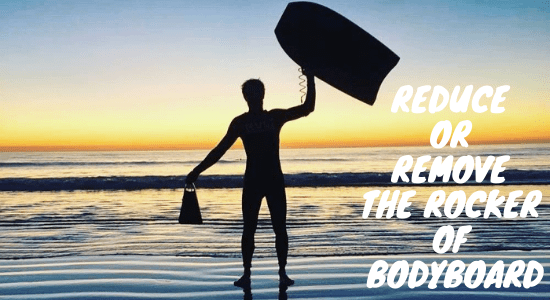Rocker is what makes a bodyboard feel so good on your feet and catch waves better. Rocker can also create an awkward feeling when you are trying to balance or walk around with it. For the times that you want to reduce or remove the rocker, following these simple steps will help!
what is a bodyboard rocker?
A rocker is the curve of your bodyboard that moves in an upward direction and creates a feeling of being on top of the wave. Rocker also helps catch waves better because it lifts before dropping down, forcing water to pass underneath you. This makes for more even distribution between weighting front foot and back foot during turns on a wave
Rockers are created by shaping foam cutouts into curves from one side or end then attaching them with cement. The amount of rocker depends on how much curvature there is at different points along with the board. Aesthetically speaking, less curviness usually equals more maneuverability while too little will make it hard to catch waves.
how to reduce or remove the rocker of the bodyboard?
Step One: Remove the fins and put them in a safe place.
Step Two: With your hands, press down on the rails of the board to make sure they are evenly pressed against each other. If there is an uneven surface you will want to sand it. You can use a file for a smoother finish before proceeding with any steps below. The rocker should be gone when all four rails lay flush against one another without any gaps between them.
Step Three: Lay the bodyboard horizontally so that both ends hang off either side of something about waist high (such as two chairs). Put pressure from one end until you feel resistance at the other end. This will push out some foam and create flat spots where pressure has been applied.
Step Four: Flip the board and repeat Step Three on the other end. This ensures that both ends are even. Repeat this step a few times to create a more uniform flat surface across the entire bodyboard’s width.
Step Five: Put pressure onto one side of your chosen rail until you feel resistance at the opposite side of it (similar to Step Three). Continue repeating this process for all four rails, which will make them rise slightly from their original heights when they were laid flush against each other in Step Two. The elevated areas created by pressing down with enough force should be gradual but noticeable as an improvement over what is normally seen in rocker boards where elevation changes occur abruptly or unevenly across its length. You may need to repeat Steps Three and Four a few more times.
Step Six: Test the new flat surface of your board by carefully walking on it back and forth from one end to the other while balancing on it with both feet. If you feel unsure or unbalanced, continue repeating Step Five until you are satisfied with its comfort level underfoot. This will make for a smoother transition when transitioning off this type of board as well!
Video: how to remove a rocker from a bodyboard?
conclusion: The amount of rocker is decided by the preference and skill level of the surfer. It depends on how much curvature there is at different points along with the board. Aesthetically speaking, less curviness usually equals more maneuverability while too little will make it hard to catch waves. Many factors go into deciding what type of rocker you need for your bodyboard: length (shortboards typically have a lot of curves), wave size(big waves, medium, and small waves), your surf style (foot forward surfing vs regular surfing)
check out our best bodyboard suggestions here



